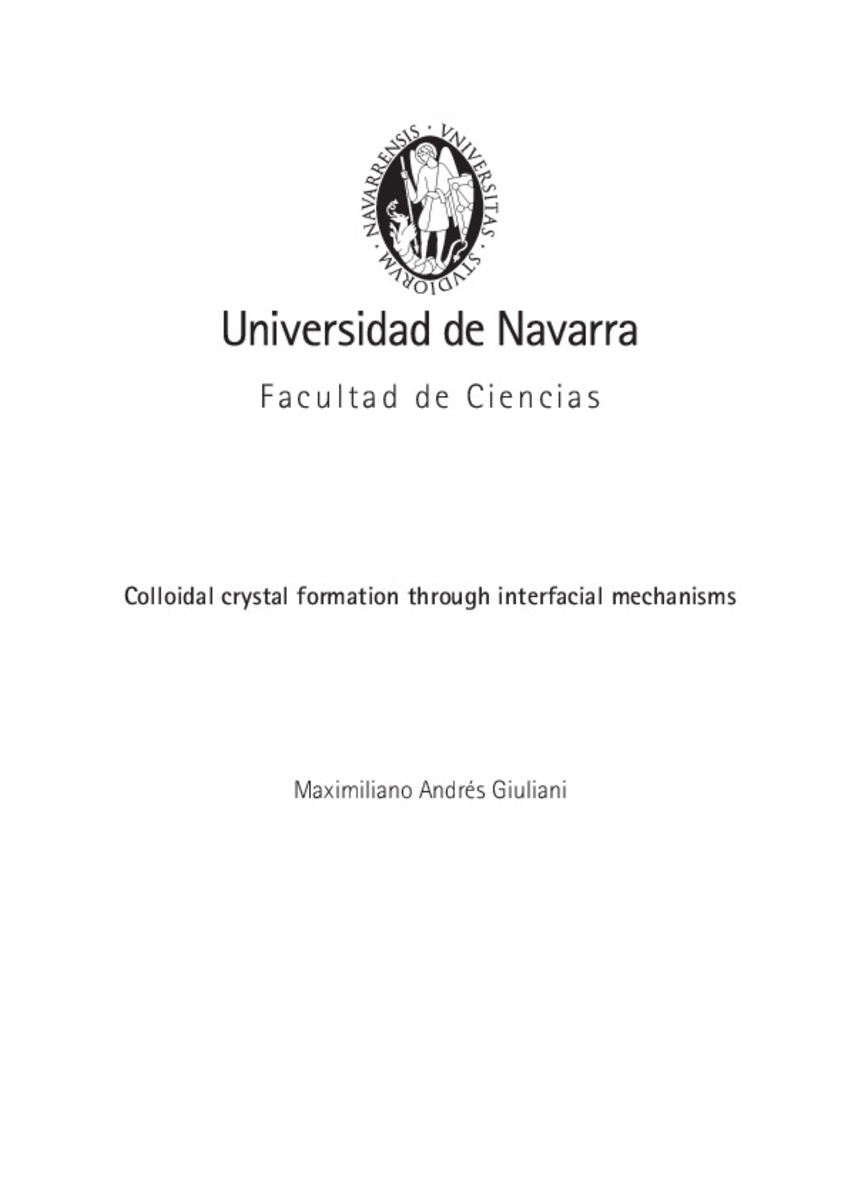Full metadata record
| DC Field | Value | Language |
|---|---|---|
| dc.contributor.advisor | Gonzalez-Viñas, W. (Wenceslao) | - |
| dc.creator | Giuliani, M. (Maximiliano) | - |
| dc.date.accessioned | 2010-10-21T15:00:17Z | - |
| dc.date.available | 2010-10-21T15:00:17Z | - |
| dc.date.issued | 2010 | - |
| dc.date.submitted | 2010-09 | - |
| dc.identifier.citation | GIULIANI, M. “Colloidal crystal formation through interfacial mechanisms”. González-Viñas, Wenceslao. Tesis doctoral. Universidad de Navarra, Pamplona, 2010 | es_ES |
| dc.identifier.isbn | 84-8081-88-2 | - |
| dc.identifier.uri | https://hdl.handle.net/10171/13612 | - |
| dc.description.abstract | In this work, we concentrate on the dynamical process that give rise to the structure in two experimental setups: vertical deposition and spin-coating. In the first case, the system is allowed to develop naturally. A weak DC electric field is applied to evaluate its effect on the dynamics. In the second case, a rotating substrate imposes an axisymmetric geometry that allows to study the dynamics of the particle structuring in relatively thin films (< 10 μm). Here, we used highly volatile fluids that give a fast crystal formation process (∼ 1 s). This report is composed of two parts each of which encompasses one of the experimental systems studied. The first part starts with an introductory chapter on the main characteristic of colloidal systems, we briefly review the principal electrokinetic phenomena that can occur in an electrostatically stabilised colloidal system. Then, we focus on the models that had been developed to predict the behaviour in convective self-assembly experiments in vertical deposition configurations. The following two chapters are dedicated to the detailed description of the experimental setup and results, with a special focus in the calculation process and the difficulties that arose from the discretisation of the data. We present the different structures and velocities observed at the conditions studied. This part finishes with a discussion on the relation between the contact line velocities and the deposited structure. We finish this section with a detailed discussion on the different parameters that affect the deposition process (previously deposited structure, local concentration near the contact line and interaction between particles and substrate) which give rise to the observed dynamics. In the spin-coating part, we first present a basic model developed by Emslie in 1958 for non-volatile viscous fluids [9] and its extension to volatile fluids made by Meyerhofer in 1978. Then, we briefly introduce the results obtained by several groups regarding the order that emerges in sheared colloidal suspensions. Then, we present the experimental setup and the image analysis used to characterise the thinning and drying dynamics. We finally describe the characterisation performed over the dried structure: via Atomic Force Microscopy (AFM) and Scanning Electron Microscopy (SEM). The results chapter summarises the thickness measured at the different conditions for the fluid stage and the dried structure. We also present the evolution of the dynamics of the long range orientational order, the dynamical regimes in the transition from the fluid suspension to the dried structure, and the difference in the morphology of the final deposit observed in the dried structure. The discussion chapter begins with an extension of the Emslie model to incorporate the evaporation rate effect on the dynamics. Then, we estimate the evaporation rate during the final dried stage using the different experimental data compiled. Finally, we discuss on the long range orientational order emerging in the fluid and dried structure. This report finalises presenting the concluding remarks and outlooks for each experimental system. | es_ES |
| dc.language.iso | eng | es_ES |
| dc.publisher | Servicio de Publicaciones de la Universidad de Navarra | es_ES |
| dc.rights | info:eu-repo/semantics/openAccess | es_ES |
| dc.subject | Materias Investigacion::Física | es_ES |
| dc.title | Colloidal crystal formation through interfacial mechanisms | es_ES |
| dc.type | info:eu-repo/semantics/doctoralThesis | es_ES |
Files in This Item:
Statistics and impact
Items in Dadun are protected by copyright, with all rights reserved, unless otherwise indicated.






